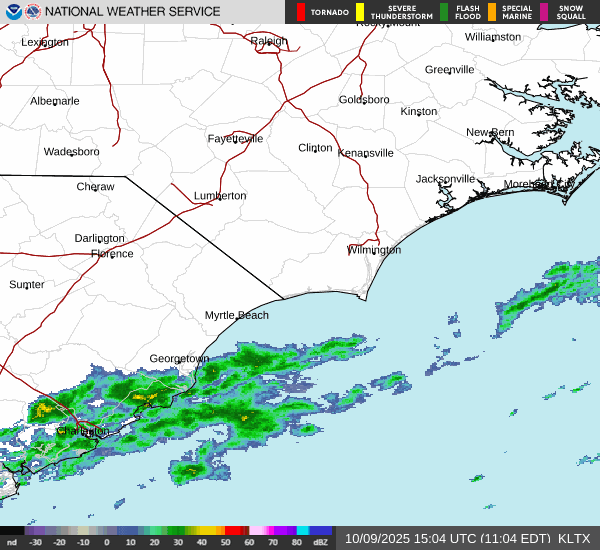A coastal storm that could become the season’s first Nor’easter is moving up the East Coast this weekend, potentially affecting areas from Florida to Massachusetts.
Forecasters warn that coastal communities could see some of the highest tides of the season, coinciding with extreme astronomical tides amplified by this week’s full Harvest Moon, which was also a supermoon.
“The main story in the extended continues to be the development and track of a coastal low in the Sat to Mon time period,” the National Weather Service office in Raleigh wrote in an area forecast discussion on Thursday, Oct. 9. “The jury is still out on its overall track, regarding whether it takes a more western position close to the Outer Banks by Sun, or whether it stays offshore per the Canadian solution. Even a look at the ensembles, there still appears to be some decent spread.”
Though the exact track of the coastal storm is undecided, forecasters warn that North Carolina may face heavy rain, strong winds and localized flooding as the system moves north.
What is a Nor’easter?
A Nor’easter is a storm along the East Coast of North America that typically blow over coastal areas. These storms can occur at any time of year but are most frequent and most intense between September and April, according to the National Weather Service.
Nor’easters usually develop between Georgia and New Jersey, within about 100 miles of the coast, and generally move northeastward, reaching maximum intensity near New England and the Canadian Maritime Provinces. They often bring heavy precipitation — rain or snow — along with gale-force winds, rough seas and sometimes coastal flooding.
Potential impacts of the Nor’easter in North Carolina
-
Heavy rain: May reduce visibility and create localized flooding in coastal areas.
-
Strong winds: Northeasterly gusts could exceed 30 knots, with sustained winds of 30-35 knots and gusts near 40 knots, posing hazards for marine and coastal travel.
-
Marine hazards:
-
Seas of 6-8 feet expected along exposed waters east of Cape Fear and Winyah Bay.
-
Gale Warning in effect; small craft operators advised to stay in port.
-
-
Coastal flooding: Minor flooding possible along beaches and low-lying areas, including downtown Wilmington and the lower Cape Fear River, due to high tides amplified by last week’s full moon.
-
Rip currents: High risk along New Hanover County beaches through the weekend.
-
Reduced visibility: Heavy rain and gusty winds could make driving and boating hazardous.
How do Nor’easters develop?
The U.S. East Coast provides an ideal environment for Nor’easters. In winter, the polar jet stream pushes cold Arctic air south across Canada and the U.S., then east toward the Atlantic Ocean, according to the National Weather Service. At the same time, warm air from the Gulf of Mexico and the Atlantic moves northward. The contrast between the cold land air and relatively warm coastal waters — kept mild by the Gulf Stream — fuels these storms, creating the strong winds and precipitation that define a Nor’easter.
Do Nor’easters always have snow?
No. Whether a Nor’easter brings snow, rain, or a mix depends on the storm’s track and temperatures:
-
Snow: Most common in the northern Mid-Atlantic and New England when Arctic air dominates.
-
Rain: More likely in the Southeast and southern Mid-Atlantic, where temperatures are warmer.
-
Mixed precipitation: Possible in areas near the transition zone, with sleet or freezing rain.
Even without snow, Nor’easters can still produce strong winds, heavy rain, rough seas and coastal flooding, making them dangerous storms regardless of the type of precipitation.
Why is it called Nor’easter?
It’s called a Nor’easter because of the direction of the prevailing winds during the storm. In these systems, the winds along the coast usually blow from the northeast.
How do Nor’easters differ from tropical storms or hurricanes?
Nor’easters are typically associated with colder seasons and form from a temperature contrast between cold Arctic air and relatively warm Atlantic waters.
Tropical storms and hurricanes form over warm tropical or subtropical waters, and predominantly develop in warmer months.
Nor’easters also have a larger wind field, while tropical storms have a well-defined eye with the strongest winds near the center.
North Carolina weather radar
North Carolina weather watches and warnings
Interactive map: Hurricanes, tropical storms that have passed near your city
Stay informed. Get weather alerts via text
Brandi D. Addison covers weather across the United States as the Weather Connect Reporter for the USA TODAY Network.
This article originally appeared on Wilmington StarNews: Is there a Nor’easter this weekend? What to expect in North Carolina









